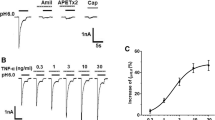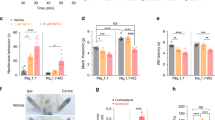Abstract
Tetrodotoxin-resistant (TTX-R) sodium channels NaV1.8 and NaV1.9 in dorsal root ganglion (DRG) neurons play important roles in pathological pain. We recently reported that melittin, the major toxin of whole bee venom, induced action potential firings in DRG neurons even in the presence of a high concentration (500 nM) of TTX, indicating the contribution of TTX-R sodium channels. This hypothesis is fully investigated in the present study. After subcutaneous injection of melittin, NaV1.8 and NaV1.9 significantly upregulate mRNA and protein expressions, and related sodium currents also increase. Double immunohistochemical results show that NaV1.8-positive neurons are mainly medium- and small-sized, whereas NaV1.9-positive ones are only small-sized. Antisense oligodeoxynucleotides (AS ODNs) targeting NaV1.8 and NaV1.9 are used to evaluate functional significance of the increased expressions of TTX-R sodium channels. Behavioral tests demonstrate that AS ODN targeting NaV1.9, but not NaV1.8, reverses melittin-induced heat hypersensitivity. Neither NaV1.8 AS ODN nor NaV1.9 AS ODN affects melittin-induced mechanical hypersensitivity. These results provide previously unknown evidence that upregulation of NaV1.9, but not NaV1.8, in small-sized DRG neurons contributes to melittin-induced heat hypersensitivity. Furthermore, melittin-induced biological effect indicates a potential strategy to study properties of TTX-R sodium channels.




Similar content being viewed by others
References
Amaya, F., Wang, H., Costigan, M., et al. (2006). The voltage-gated sodium channel Na(v)1.9 is an effector of peripheral inflammatory pain hypersensitivity. Journal of Neuroscience, 26, 12852–12860.
Baker, M. D., Chandra, S. Y., Ding, Y., Waxman, S. G., & Wood, J. N. (2003). GTP-induced tetrodotoxin-resistant Na + current regulates excitability in mouse and rat small diameter sensory neurones. Journal of Physiology, 548, 373–382.
Basbaum, A. I., Bautista, D. M., Scherrer, G., & Julius, D. (2009). Cellular and molecular mechanisms of pain. Cell, 139, 267–284.
Cardenas, L. M., Cardenas, C. G., & Scroggs, R. S. (2001). 5HT increases excitability of nociceptor-like rat dorsal root ganglion neurons via cAMP-coupled TTX-resistant Na(+) channels. Journal of Neurophysiology, 86, 241–248.
Chen, J., & Lariviere, W. R. (2010). The nociceptive and anti-nociceptive effects of bee venom injection and therapy: A double-edged sword. Progress in Neurobiology, 92, 151–183.
Chen, Y. N., Li, K. C., Li, Z., et al. (2006). Effects of bee venom peptidergic components on rat pain-related behaviors and inflammation. Neuroscience, 138, 631–640.
Chen, J., Luo, C., Li, H., & Chen, H. (1999). Primary hyperalgesia to mechanical and heat stimuli following subcutaneous bee venom injection into the plantar surface of hindpaw in the conscious rat: A comparative study with the formalin test. Pain, 83, 67–76.
Coste, B., Crest, M., & Delmas, P. (2007). Pharmacological dissection and distribution of NaN/Nav1.9, T-type Ca2 + currents, and mechanically activated cation currents in different populations of DRG neurons. Journal of General Physiology, 129, 57–77.
Coste, B., Osorio, N., Padilla, F., Crest, M., & Delmas, P. (2004). Gating and modulation of presumptive NaV1.9 channels in enteric and spinal sensory neurons. Molecular and Cellular Neuroscience, 26, 123–134.
Cummins, T. R., Dib-Hajj, S. D., Black, J. A., Akopian, A. N., Wood, J. N., & Waxman, S. G. (1999). A novel persistent tetrodotoxin-resistant sodium current in SNS-null and wild-type small primary sensory neurons. Journal of Neuroscience, 19, C43.
Dai, Y., Fukuoka, T., Wang, H., Yamanaka, H., Obata, K., Tokunaga, A., et al. (2004). Contribution of sensitized P2X receptors in inflamed tissue to the mechanical hypersensitivity revealed by phosphorylated ERK in DRG neurons. Pain, 108, 258–266.
Dib-Hajj, S., Black, J. A., Cummins, T. R., & Waxman, S. G. (2002). NaN/Nav1.9: A sodium channel with unique properties. Trends in Neurosciences, 25, 253–259.
Du, Y. R., Xiao, Y., Lu, Z. M., et al. (2011). Melittin activates TRPV1 receptors in primary nociceptive sensory neurons via the phospholipase A2 cascade pathways. Biochemical and Biophysical Research Communications, 408, 32–37.
England, S., Bevan, S., & Docherty, R. J. (1996). PGE2 modulates the tetrodotoxin-resistant sodium current in neonatal rat dorsal root ganglion neurones via the cyclic AMP-protein kinase A cascade. Journal of Physiology, 495, 429–440.
Fang, X., Djouhri, L., Black, J. A., Dib-Hajj, S. D., Waxman, S. G., & Lawson, S. N. (2002). The presence and role of the tetrodotoxin-resistant sodium channel Na(v)1.9 (NaN) in nociceptive primary afferent neurons. Journal of Neuroscience, 22, 7425–7433.
Fukuoka, T., Kobayashi, K., Yamanaka, H., Obata, K., Dai, Y., & Noguchi, K. (2008). Comparative study of the distribution of the alpha-subunits of voltage-gated sodium channels in normal and axotomized rat dorsal root ganglion neurons. The Journal of Comparative Neurology, 510, 188–206.
Gold, M. S. (1999). Tetrodotoxin-resistant Na + currents and inflammatory hyperalgesia. Proceedings of the National Academy of Sciences of the United States of America, 96, 7645–7649.
Goldin, A. L. (2001). Resurgence of sodium channel research. Annual Review of Physiology, 63, 871–894.
Hao, J., Liu, M. G., Yu, Y. Q., Cao, F. L., Li, Z., Lu, Z. M., et al. (2008). Roles of peripheral mitogen-activated protein kinases in melittin-induced nociception and hyperalgesia. Neuroscience, 152, 1067–1075.
Hillsley, K., Lin, J. H., Stanisz, A., Grundy, D., Aerssens, J., Peeters, P. J., et al. (2006). Dissecting the role of sodium currents in visceral sensory neurons in a model of chronic hyperexcitability using Nav1.8 and Nav1.9 null mice. Journal of Physiology, 576, 257–267.
Katz, E. J., & Gold, M. S. (2006). Inflammatory hyperalgesia: A role for the C-fiber sensory neuron cell body? Journal of Pain, 7, 170–178.
Li, K. C., & Chen, J. (2004). Altered pain-related behaviors and spinal neuronal responses produced by s.c. injection of melittin in rats. Neuroscience, 126, 753–762.
Lu, Z. M., Xie, F., Fu, H., Liu, M. G., Cao, F. L., Hao, J., et al. (2008). Roles of peripheral P2X and P2Y receptors in the development of melittin-induced nociception and hypersensitivity. Neurochemical Research, 33, 2085–2091.
McCleskey, E. W., & Gold, M. S. (1999). Ion channels of nociception. Annual Review of Physiology, 61, 835–856.
Mogil, J. S. (2009). Animal models of pain: progress and challenges. Nature Reviews Neuroscience, 10, 283–294.
Ostman, J. A., Nassar, M. A., Wood, J. N., & Baker, M. D. (2008). GTP up-regulated persistent Na + current and enhanced nociceptor excitability require NaV1.9. Journal of Physiology, 586, 1077–1087.
Pawlak, M., Stankowski, S., & Schwarz, G. (1991). Melittin induced voltage-dependent conductance in DOPC lipid bilayers. Biochimica et Biophysica Acta, 1062, 94–102.
Porreca, F., Lai, J., Bian, D., et al. (1999). A comparison of the potential role of the tetrodotoxin-insensitive sodium channels, PN3/SNS and NaN/SNS2, in rat models of chronic pain. Proceedings of the National Academy of Sciences of the United States of America, 96, 7640–7644.
Priest, B. T., Murphy, B. A., Lindia, J. A., et al. (2005). Contribution of the tetrodotoxin-resistant voltage-gated sodium channel NaV1.9 to sensory transmission and nociceptive behavior. Proceedings of the National Academy of Sciences of the United States of America, 102, 9382–9387.
Raghuraman, H., & Chattopadhyay, A. (2007). Melittin: a membrane-active peptide with diverse functions. Bioscience Reports, 27, 189–223.
Renganathan, M., Cummins, T. R., & Waxman, S. G. (2001). Contribution of Na(v)1.8 sodium channels to action potential electrogenesis in DRG neurons. Journal of Neurophysiology, 86, 629–640.
Rex, S. (1996). Pore formation induced by the peptide melittin in different lipid vesicle membranes. Biophysical Chemistry, 58, 75–85.
Rush, A. M., Dib-Hajj, S. D., Liu, S., Cummins, T. R., Black, J. A., & Waxman, S. G. (2006). A single sodium channel mutation produces hyper- or hypoexcitability in different types of neurons. Proceedings of the National Academy of Sciences of the United States of America, 103, 8245–8250.
Rush, A. M., & Waxman, S. G. (2004). PGE2 increases the tetrodotoxin-resistant Nav1.9 sodium current in mouse DRG neurons via G-proteins. Brain Research, 1023, 264–271.
Shin, H. K., & Kim, J. H. (2004). Melittin selectively activates capsaicin-sensitive primary afferent fibers. NeuroReport, 15, 1745–1749.
Tanaka, M., Cummins, T. R., Ishikawa, K., Dib-Hajj, S. D., Black, J. A., & Waxman, S. G. (1998). SNS Na + channel expression increases in dorsal root ganglion neurons in the carrageenan inflammatory pain model. NeuroReport, 9, 967–972.
Yu, Y. Q., & Chen, J. (2005). Activation of spinal extracellular signaling-regulated kinases by intraplantar melittin injection. Neuroscience Letters, 381, 194–198.
Yu, Y. Q., Zhao, F., Guan, S. M., & Chen, J. (2011). Antisense-mediated knockdown of NaV1.8, but not NaV1.9, generates inhibitory effects on complete Freund’s adjuvant-induced inflammatory pain in rat. PLoS ONE, 6, e19865.
Acknowledgments
This study was partially supported by the National Natural Science Foundation of China (81070899, 81171049 and 31100803) and 973 program (2011CB504100).
Conflict of interest
The authors declare no conflict of interest.
Author information
Authors and Affiliations
Corresponding author
Additional information
Yao-Qing Yu and Zhen-Yu Zhao equally contributed to the work.
Electronic supplementary material
Below is the link to the electronic supplementary material.
12017_2012_8211_MOESM1_ESM.tif
Supplementary Figure 1 Action potential firings induced by melittin and electrical stimuli maintained in the presence of high concentration of TTX. (A) Application of melittin (1 μM, 50 s) to a DRG neuron produced slow membrane depolarization and tonic action potential firing lasting for about 500 s. Although administration of 500 nM TTX could suppress the response of action potentials, the tonic firings maintained in one DRG neuron. (B) Different current injections (intensity, 200, 400 and 500 pA; duration, 3 ms and 500 ms with a 200 ms interpulse at the holding potential) produced increased firings of action potential in one DRG neuron and the electrical-evoked responses remained in the presence of 500 nM TTX. Dotted line indicated the resting membrane potential of the DRG neuron (TIFF 1603 kb)
12017_2012_8211_MOESM2_ESM.tif
Supplementary Figure 2 Melittin treatment increased action potential firings and the inhibitory effects of specific antisense oligodeoxynucleotides (AS ODNs). (A) After melittin treatment, action potential firings induced by current injection (intensity, 500 pA; duration, 500 ms) were significantly increased (n=13-15). (B) Compared with MM ODN, the melittin-enhanced neuronal firings were inhibited by NaV1.8 or NaV1.9 AS ODN (n=7-9). AS, antisense. MM, mismatch. ODN, oligodeoxynucleotide. *p<0.05; **p<0.01 vs. control (TIFF 765 kb)
Rights and permissions
About this article
Cite this article
Yu, YQ., Zhao, ZY., Chen, XF. et al. Activation of Tetrodotoxin-Resistant Sodium Channel NaV1.9 in Rat Primary Sensory Neurons Contributes to Melittin-Induced Pain Behavior. Neuromol Med 15, 209–217 (2013). https://doi.org/10.1007/s12017-012-8211-0
Received:
Accepted:
Published:
Issue Date:
DOI: https://doi.org/10.1007/s12017-012-8211-0




